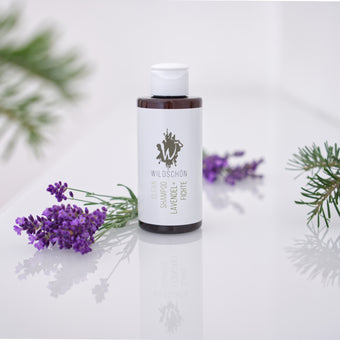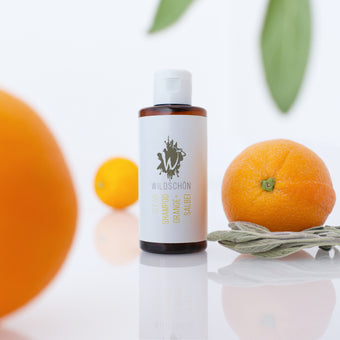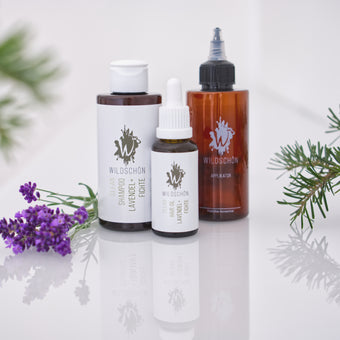Shampoo Concentrate: Prepare and apply like a pro at the hair salon
- What advantages do concentrates have over conventional shampoos?
- Why we think liquid shampoos are better than solid shampoos.
- How to use shampoo concentrates correctly.
A shampoo concentrate that is freshly prepared, just like at the noble star hairdresser, just for at home - and still easy to use? That shouldn't be a problem! At least we thought so. But the road from the first idea to the finished product was a long one, and we are all the more proud of the result: Wildschön Shampoo Concentrate meets the highest standards that we have set ourselves: absolutely natural, sustainable, clean and in professional quality.
Why a concentrate at all?
A shampoo concentrate is sustainable: Most commercially available shampoos consist of water - normally well over 90 percent. This means: If a conventional shampoo has to be transported from one place to another, there is almost exclusively water on the loading area or in the transport container. The transport weight is ten times as high as that of the concentrate, so the energy consumption is correspondingly higher. So why should we send trucks or mail carriers onto the streets with a load of water? The water from your tap is absolutely great in Germany! Hardly any food is controlled as strictly as tap water. And if you're now thinking: "But there's limescale in tap water..." That's true, of course, but as long as you wash your hair with tap water, the difference of a few milliliters in the shampoo isn't really relevant.
Our strict clean beauty rules
The purity of our Wildschön shampoos is even more important to us than sustainability: Our goal is to offer you the cleanest shampoo with as few harmful ingredients as possible. This protects both you and the environment. And this is where the biggest advantage of the concentrated form of our shampoos lies: By using concentrate we can do without preservatives, because they last much longer without chemical additives. So-called parabens, for example, which have been shown to have a weak hormone-like effect, are usually used in shampoos. Of course, manufacturers in Germany adhere to the official recommendations and use parabens sparingly, but they have absolutely no place in our natural shampoos - we promise! Also, you probably know that oil and water, for example, don't really like each other: if you mix them, the lighter oil will sooner or later settle on top of the liquid. To prevent this, many manufacturers use synthetic emulsifiers. We also consistently avoid that. For this reason, you have to shake our concentrate briefly before mixing it. shake it baby
Why liquid instead of solid?
For us, the most important argument for liquid shampoo is the application, because the liquid ends up exactly where it belongs with the applicator bottle: on the scalp. In order to get the shampoo bar down to the scalp, some users tend to apply too much pressure when applying. This can damage the hair. Normally, however, you will use little pressure in view of the tugging and distribute the solid shampoo in the hair without too much of it reaching the scalp before it is completely lathered. As a result, it is possible that not many of the active ingredients reach the scalp. Another major problem with hair soap is its pH value: a value of 9 to 10 is normal for soap. For comparison: the pH of your skin is around 5.5. Manufacturers have come up with a few tricks to protect the scalp from drying out: They add glycerin, for example, a substance that penetrates deep into the cells and is used as a moisture regulator. However, the effect of glycerin is highly dependent on environmental factors , so it can even dry out the skin. Glycerine is also often used by many natural cosmetics manufacturers, but we consistently do without it in our Clean Shampoo Concentrate.
Preparation: Mix in the applicator bottle
Wildschön's applicator bottle is the easiest way to mix our concentrate: After briefly shaking the Clean Shampoo, fill the mixing bottle with the concentrate up to the bottom line - that's about 15ml. Our shampoo is highly concentrated so a 1 to 10 mix ratio is great to get the best mix. That means: You simply fill the bottle up with tap water. Twist, shake, done. The finished shampoo in an applicator bottle is sufficient for about 3 to 5 hair washes - depending on hair length and hair condition. However, especially at the beginning you can use a little more to make the transition easier. A little tip: If the tap water in your home is very cold, you can experiment with low-mineral water from various beverage manufacturers instead of mixing our concentrate with "Kranberger". As long as you then wash your hair with tap water, the effect is not very great, but some of our testers have had positive experiences with this method.
Apply, distribute, wash out: This is how natural shampoo works
In the shower, use the applicator bottle to apply the mixed shampoo to the dry scalp, parting the parting first. The applicator bottle divides the strands by itself - don't worry about the exact division - the main thing is that the scalp is evenly moistened everywhere. You feel this automatically because your shampoo is normally at room temperature and it lies comfortably cooling on the scalp. Then massage it in gently with your fingertips for about a minute. Make sure that you only make small movements so that your hair does not get tangled. Now you rinse the shampoo out with water for the first time, whereby the shampoo is already distributed into the hair. Also for the second application, proceed parting by parting and apply the shampoo directly to the scalp. From there you distribute it with gentle pressure into the hair - down to the ends of the hair. If you're new to natural hair care, you might be surprised at first that there's a lot less lather than with conventional shampoos. However, this is absolutely normal and wanted, because we do not use any strong foaming additives. You'll see: the cleaning effect is still very good and your hair will feel great as soon as it gets used to the new shampoo.
After application
After washing, the hair can of course be dried and styled as normal. However, if you are just switching to natural hair shampoo, you should keep in mind that it may take a few days or weeks for your hair to get used to the new way of care. Especially if you have used conventional products all your life, you must gradually wean them off chemical softeners and smoothing agents. Your hair could be a bit stubborn at first. But don't worry: if you survive this phase, you will be rewarded with naturally soft and silky hair without chemicals.









